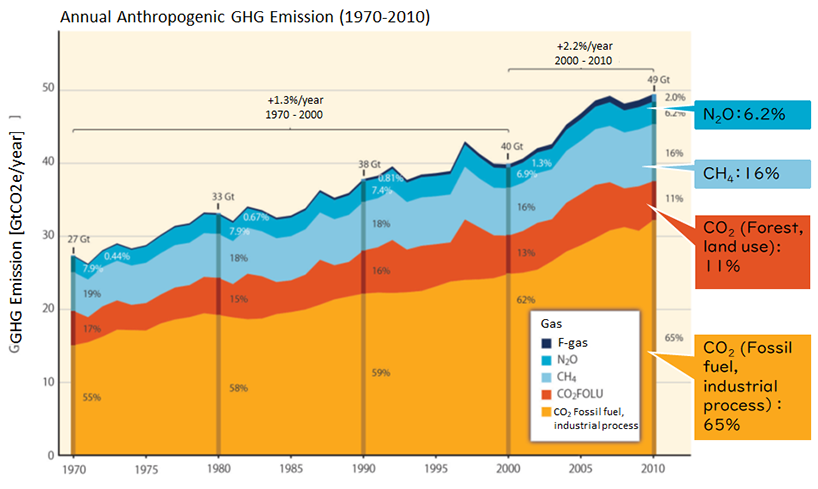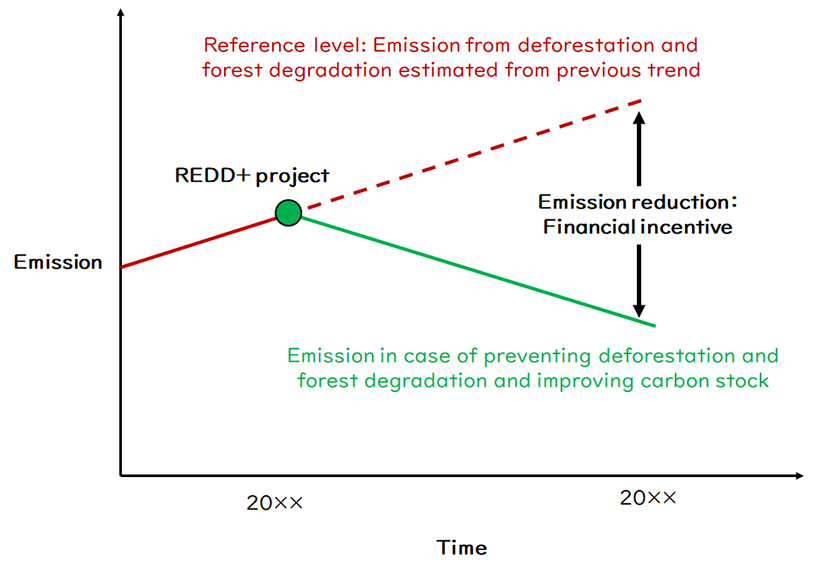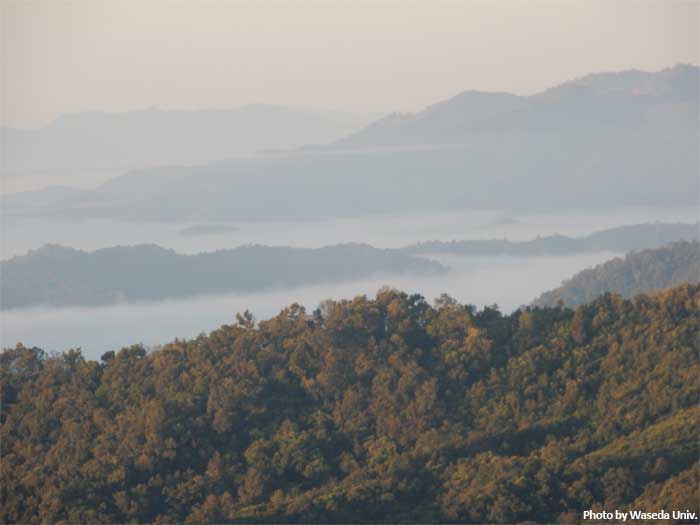Current Discussion in UNFCCC and other international framework
REDD/REDD+
<Outline>
- Definition and Background of REDD/REDD+
- A Brief History of REDD/REDD+
- REDD+ activities under the JCM
- Forestry sector and market mechanisms
Definition and Background of REDD/REDD+
Importance of reducing emissions from deforestation and forest degradation
Forests provide various ecosystem services and play a significant role in absorbing CO2 and storing carbon in terms of climate change measures. It is expected that risks of disasters such as heavy rainfall and extreme heat will increase due to the changing climate. Since the deforestation directly affects CO2 emissions, further climate action in forests are required.
According to the IPCC Fifth Assessment Report published in 2014, CO2 emission from LULUCF sector accounts for 11% of the total anthropogenic GHG emission in the world. (The number is 13% in IPCC Special Report on Climate Change and Land published in 2019) This is the second biggest CO2 emission source after the emission from fossil fuel (65%). Therefore, prevention of deforestation is a short-term and direct climate mitigation option.
The Paris Agreement adopted in 2015 requires parties to achieve a balance between anthropogenic emissions by sources and removals by sinks of greenhouse gases in the second half of this century in order to achieve the goal to hold the increase in the global average temperature to well below 2°C above pre-industrial levels and to pursue efforts to limit the temperature increase to 1.5°C above pre-industrial levels.
In regard to forest sink measures, it is required to implement activities to conserve and enhance the function of carbon sink, and to support reducing emissions from deforestation and forest degradation in developing countries (REDD+).

Source:Created from the IPCC Fifth Assessment Report WG3
What is REDD/REDD+
It is considered that deforestation is caused by logging and land use change to agriculture due to the population increase and expanding demands for foods and lands. Large-scale deforestations are occurring in tropical regions particularly in south America and Africa. Progress of deforestation in those areas during 2010 to 2015 was drastically slowed down compared to 1990s. However, there remains many issued to be addressed such as unsustainable forest operations and land use changes. In this regard, various actions are implemented against deforestation and forest degradation in developing countries.
REDD means “Reducing Emissions from Deforestation and Forest Degradation in Developing Countries” to reduce emissions by economically incentivizing preventing deforestation and forest degradation in developing countries. While REDD focuses on preventing deforestation and forest degradation, REDD+ is to implement forest conservation, sustainable forest management and forest sink improvement in addition to the REDD activities.
Fundamental framework of REDD+ was decided at COP19 of the UNFCCC in 2013. Later, actions by Parties to implement and support REDD+ was encouraged in the Article 5.2 of Paris Agreement adopted in 2015 at COP21.
Currently, various pilot projects and capacity building in developing countries are implemented by developed countries, international organizations, private companies and NGOs. Further discussions towards financial and technical issues are continued through learning from those experiences. In addition to bilateral cooperation with developed countries including Japan, following international organizations are developing and supporting preparation activities (such as capacity building, technical assistance, REDD strategy and regulation) and pilot projects towards REDD+ implementation in developing countries.
- Forest Carbon Partnership Facility:FCPF:
The FCPF is operated by World Bank to support REDD+ projects through the global partnership of civil society and Indigenous Peoples. 47 developing countries across Africa, Asia, and Latin America and the Caribbean are participating in the FCPF. The FCPF consists of two funds: The FCPF Readiness Fund to prepare REDD+ implementation and the FCPF Carbon Fund with results-based payments to countries for achieved emission reductions in their forest and broader land-use sectors. - UN-REDD Programme:
The UN-REDD Programme is a collaborative programme of the FAO, UNDP and UNEP which is supporting development and implementation of national level REDD+ programmes in 65 countries across Africa, Asia-Pacific, and Latin America. - GCF REDD+ Results-based Payments Pilot:
The GCF is an operating entity of the Financial Mechanism of the UNFCCC. Various supports are provided to developing countries via Accredited Entities including national, sub-national, regional, international and private entities approved to access the fund. Regarding the REDD+, support of preparation activities and pilot programme of results-based payments are implemented. JICA and MUFG are approved as Accredited Entities from Japan.
Fundamental concept of the REDD+ is to set a reference level (dotted line) based on the trend of previous deforestation and associated emission, and to evaluate emission in case of preventing deforestation and forest degradation through REDD+ activities (solid line) compared with the reference level.

Source:Created from “REDD-plus:GHG emission reduction through preventing deforestation and forest degradation- Forest conservation in developing countries” (JICA and ITTO, 2010)
Some issues including 1) Setting of reference level, 2) Development of monitoring method, 3) Governance and consideration for indigenous peoples and biodiversity are identified as challenges for the REDD+, and technical studies are proceeding. In addition, some voluntary guidelines have been developed led by private standards such as VCS and CCBS.
A Brief History of REDD/REDD+
<International History>
| Year | Meeting (Location) | Activity and Decision |
|---|---|---|
| 2005 | COP11 (Montreal) |
Papua New Guinea and Costa Rica proposed the idea of issuing carbon credits from REDD and avoiding deforestation in developing countries. It was decided that the related discussions should be concluded within two years. Subsequently, the SBSTA (Subsidiary Body for Scientific and Technological Advice) and workshops coordinated by SBSTA started their reviews. |
| 2007 | COP13 (Bali) |
The nations pledged "Policy approaches and positive incentives on issues relating to reducing emissions from deforestation and forest degradation (REDD) in developing countries; and the role of conservation, sustainable management of forests and enhancement of forest carbon stocks in developing countries." The adoption of the Bali Road Map resulted in the broader concept of REDD+, which also includes consideration of the roles of forest conservation, sustainable forest management, and increasing forest area carbon stocks. |
| 2008 | COP14 (Poznan) |
Concept of REDD+ formalized and becomes common internationally. |
| 2009 | COP15 (Copenhagen) |
The Copenhagen Accord explicitly recognized the crucial role of both REDD and the emissions removals provided by forests and agreed on the need to incentivize related activities through the establishment of a REDD+ mechanism that would aid in mobilizing financial resources from developed countries. |
| 2010 | COP16 (Cancun) |
The Cancun Agreement recognized the importance of REDD-plus and clarified the scope of REDD-plus activities, including (i) Reducing emissions from deforestation; (ii) Reducing emissions from forest degradation; (iii) Conservation of forest carbon stocks; (iv) Sustainable management of forests and (v) Enhancement of forest carbon stocks. The Decision also identified the systems and information needed to partake in REDD+ activities by requesting that developing country Parties support REDD+ activities through developing: i) a national strategy or action plan; ii) a national forest reference emission level and/or forest reference level; iii) a robust and transparent national forest monitoring system for REDD+ activities, and; iv) a system for providing information on how REDD+ safeguards (to avoid negative social and environmental outcomes) are being addressed and adhered to. |
| 2011 2012 |
COP17 (Durban) |
With regards to Safeguard, Decision provided guidance on systems for providing information on how safeguards are addressed and included guidance on reference levels and/or reference emission levels. It was agreed that results-based financing for developing country Parties may come from a variety of sources, including public, private, bilateral and multilateral. |
| Kenya | Voluntary programme of REDD+ was started. The first REDD+ project was certified by the VCS in Kenya. | |
| COP18 (Doha) |
Methodological guidance on developing modalities for a national forest monitoring system (NFMS) and for measuring, reporting and verifying (MRV) of REDD-plus activities was discussed. Parties identified several tracks of work, including a COP work programme, to enable the continued consideration of issues relating to financing for the full implementation of results-based actions on REDD-plus. | |
| 2013 | COP19 (Warsaw) |
The "Warsaw Framework for REDD Plus", which includes seven decisions such as national monitoring system, summary of information of safeguard, Drivers of deforestation and forest degradation, forest reference emission levels, MRV of forest related-emission, REDD+ finance and coordination of finance, were adopted. |
| 2014 | Lima | First Voluntary Meeting on the Coordination of Support for the Implementation of REDD+ Activities was held and held annually thereafter. |
| 2015 | COP21 (Paris) |
Paris Agreement adopted. Article 5.2 encourages implementing and supporting REDD+. Agreed on leftover issues from COP19 including safeguard information and methodological issues on non-carbon benefits. |
| 2017 | COP23/SBI47 (Bonn) |
Coordination of supports for REDD+ was discussed in SBI47. Parties couldn’t reach an agreement and held off a decision to next meeting (SBI48). |
| 2018 | SBI48 | Parties concluded on closing the discussion on coordination of supports for REDD+ in SBI48. |
Source:
- UNFCCC Decision booklet REDD+
- The REDD desk "What is REDD+?" (Accessed on 2013/12/15)
- REDD Research and Development Center
- Voluntary meetings on the coordination of support for the REDD+
<Domestic History in Japan>
| Year | Activity |
|---|---|
| 2009 | METI and MOE implemented 11 feasibility studies on REDD+. |
| 2010 | REDD Research and Development Center was established in Forest Research and Management Organization as comprehensive technological base regarding REDD+ in Japan. |
| 2010 | METI started JCM feasibility study on REDD+. |
| 2011 | MOE started JCM feasibility study on REDD+. |
| 2015-2017 | MOE started JCM REDD+ Model Project programme. |
| 2018 | Joint Committee between Japan and Cambodia adopted REDD+ rules under the JCM (The first JCM-REDD+ implementation rule) |
| 2019 | Joint Committee between Japan and Lao PDR adopted REDD+ rules under the JCM |
Source:
REDD+ activities under the JCM
Japan establishes and implements the Joint Crediting Mechanism (JCM) in order both to appropriately evaluate contributions from Japan to GHG emission reductions or removals in a quantitative manner achieved through the diffusion of low carbon technologies, products, systems, services, and infrastructure as well as implementation of mitigation actions in developing countries, and to use them to achieve Japan's emission reduction target.
REDD+ rules under the JCM have been developed between Cambodia and Lao PDR, and Japan also cooperate with other partner countries to promote REDD+ rule development. In addition, JCM-REDD+ Demonstration Study (2013-2014) and JCM REDD+ Model Project (2015-2017) have been implemented aiming at developing REDD+ projects
Project-cases
- A REDD+ project using ICT to make operations more efficient (JCM Feasibility Study 2013-2014)
- Cambodia: REDD+ in Tropical Lowland Forests (New Mechanisms REDD+ Feasibility Study 2011-2014)
- REDD+ project in Boalemo District (JCM REDD+ Model Project 2014-2015)
- REDD+ project in Luang Prabang Province through controlling slash-and-burn (JCM REDD+ Model Project 2014-2017)


Following websites introduce REDD+ projects.
- JICA REDD+ (PDF)
REDD+ projects can be searched in a following database. - JCM Project Database (Carbon Markets Express)
Project/Study type: JCM REDD+ Model Project, REDD+ FS, REDD+ Study - REDD+ Database (IGES)
Forestry sector and market mechanisms
Clean Development Mechanism (CDM) was developed under the Kyoto Protocol that developed countries (Annex 1 Parties) finance emission reduction projects in developing countries (Non-Annex 1 Parties), and carbon credits (CER) are issued based on achieved emission reduction. The CDM also covered forestry activities.
Paris Agreement which started full-scale operation from 2020 stipulates the use of market mechanisms in the Article 6. The rule of the Article 6 is still under negotiation in UNFCCC.
Article 6 of the Paris Agreement
International aviation sector has set a goal to achieve carbon neutral growth from 2020. Use of carbon credits generated from forestry sector is a key issue under discussion.
Carbon Offsetting and Reduction Scheme for International Aviation (CORSIA)
Reference Website
- Center for global Environmental Research
- Japan Public-Private Platform for REDD+
- Forest Partnership Platform (MOE)
- REDD Research and Development Center
- UNFCCC REDD+ Web Platform
- United Nation REDD Programme
- IGES REDD-plus online database
- WWF Japan
- Forest Carbon Partnership Facility
- The Congo Basin Forest Fund
- Forest Investment Program

